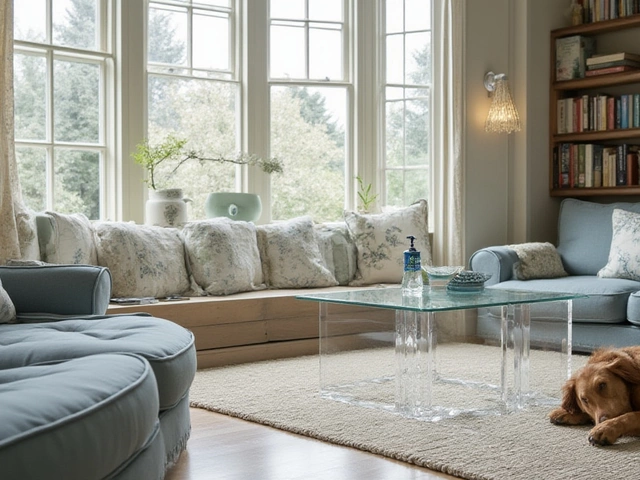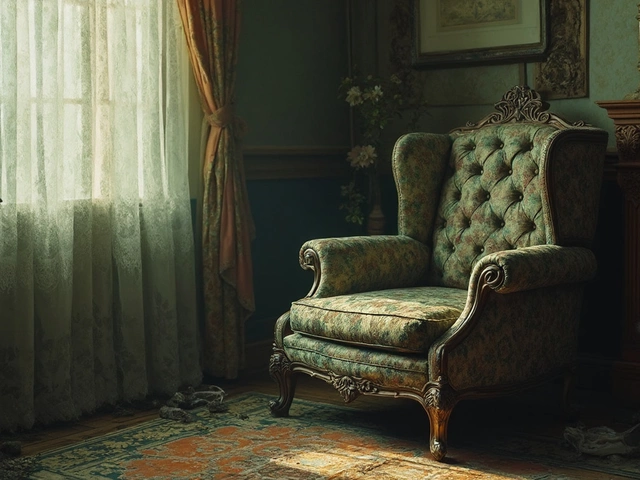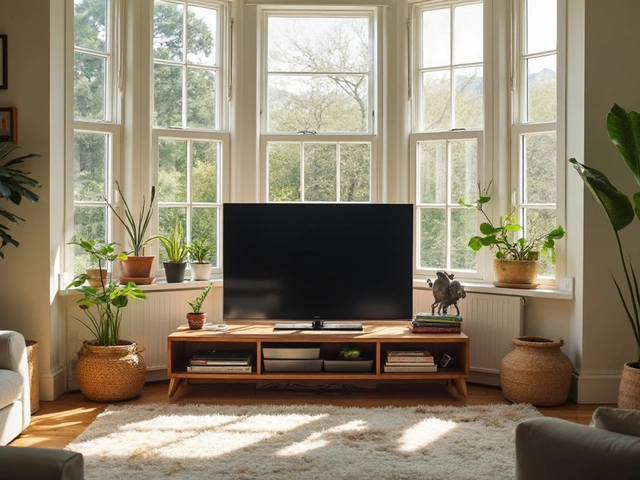 2
Feb,2025
2
Feb,2025
When we're on the hunt for a new couch or dining set, a question often pops into our minds: are we paying fair prices, or are these markups sky-high? It's an intriguing subject, one that sheds light both on industry practices and the strategies savvy shoppers can employ.
Furniture, like many products, doesn't simply cost what it costs to make. There are hidden layers, from design and branding to shipping and storage. It's no surprise that perceived value, trends, and craftsmanship can swirl into quite the price cocktail by the time furniture arrives on the showroom floor.
But how does one sift through this complexity without getting a headache—or a starkly empty wallet? Armed with some insights and tips, you can navigate the maze of furniture shopping more comfortably. Let's get into the thick of it as we explore how the pieces are priced and what we can do to snag both quality and value.
- Understanding Furniture Pricing
- Factors Influencing Markup
- Industry Insights and Secrets
- Ways to Find the Best Deals
- Making Smarter Furniture Purchases
Understanding Furniture Pricing
The journey from raw materials to the polished furniture piece in a showroom or on your device screen involves a fascinating tapestry of processes. The pricing of furniture is not arbitrary; it’s a dynamic blend of artistry, manufacturing, marketing, and consumer psychology. It starts with the choice of materials, from the richness of mahogany to the simplicity of pine, each carrying its cost implications. Beyond material costs, there's craftsmanship—an essential component that adds substantial value. Skilled artisans who fashion a chair or an intricate dining table are paid for their expertise, and this labor naturally impacts the price tag you see.
Manufacturing costs also include overhead expenses like operating the machinery, powering the facility, and complying with regulatory standards, all of which tip the expense scale. At this stage, branding steps into the spotlight. Renowned manufacturers who have established their names as symbols of quality and prestige often command higher prices, justifying these premiums by the trust they've cultivated over decades. This is where consumers see the biggest markup—the difference between the base production cost and the retail price, heavily swayed by brand image and perceived value.
As Mark R. Leger, a furniture industry veteran, puts it, "The unseen brilliance in furniture pricing is not in what you pay, but in what the market thinks you’re buying—a lifestyle or a narrative you relate to."
A crucial element influencing furniture pricing is logistics. Transporting large items is a considerable undertaking. Whether produced locally or overseas, the cost and method of transportation—be it shipping by sea or trucking cross-country—contribute to the price equation. Retailers typically need to include these costs as they balance competitive pricing with profitability, rendering every end price a careful calculus of these numerous factors. Shifting consumer preferences further complicate the picture. These can transform a once-discounted product into a high-demand item, further validating its elevated price. Understanding these layers can empower consumers to make informed choices, appreciating not just the functionality of a piece, but the journey it encapsulates from nothingness to a cornerstone of home.
Factors Influencing Markup
When it comes to furniture markup, there's more than meets the eye. The price tag you see often conceals a myriad of factors that intricately weave together to form the final cost. Let's pull back the velvet curtain and explore what directly impacts how much you end up paying at checkout. One primary factor is the cost of raw materials. Timber, metal, fabric — these basic components fluctuate in cost due to global supply and demand dynamics. For instance, a surge in demand for high-quality hardwood can substantially alter the base price for wooden furniture items. Then, there’s the cost of production, which encompasses labor wages, technology use, and manufacturing processes. Skilled craftsmanship can add to the cost significantly, especially when it involves intricate detailing and unique designs.
Brand reputation also plays a critical role. When we eye a well-known brand in the furniture world, we're not just paying for a piece of furniture; we're investing in the assurance of quality and legacy. Brands spend on marketing and maintaining their market presence, which often translates into higher price points. Distribution and logistics are crucial cogs in the pricing machinery. Shipping costs can be very high, particularly for importing exotic pieces across continents. This is coupled with warehousing expenses which add another layer to the markup pie. Additionally, retail overhead plays its part. From immaculate showrooms to informed sales personnel, the retail experience provided entails costs that trickle down to the consumer.
Decor trends contribute an ephemeral yet powerful influence that can't be ignored. What is fashionable today might not be tomorrow, compelling manufacturers to adapt rapidly. This rapid change sometimes results in surpluses or shortages, both affecting pricing. Consider a sudden spike in interest for Scandinavian designs; it can lead to increased production and promotional costs. Quoting an industry insider, Justin Fontaine, CEO of a prominent furniture brand stated,
“In the furniture world, trends dictate a lot more than just style; they shape how businesses strategize market operations.”It's a delicate dance between what customers desire and what manufacturers can supply without incurring losses.
Let’s not overlook regional economic conditions. In areas where economic prosperity blooms, people are willing to spend more, giving businesses the opportunity to adjust markups accordingly. Conversely, in a declining economy, even the most luxurious brands may lower their markups to maintain cash flow. Lastly, consider the influence of seasonal sales events and discounts. While they might seem like marketing gimmicks, these occasions often coincide with inventory clearances or new collection launches, where markups are optimized to simultaneously attract customers and manage stocks. As you dig deeper into furniture sale dynamics, you gain a more enriched perspective on what truly shapes these numbers. Modern purchasing isn't just about style or necessity; it’s a well-rounded investment guided by multifaceted influences and, dare I say, an intricate artform of commerce.

Industry Insights and Secrets
As we delve into the world behind stylish sofas and sturdy tables, it's easy to get lost in the vastness of the furniture sale maze. One of the best-kept secrets in this industry is how interconnected it truly is, ranging from manufacturing hubs to retail environments, each playing pivotal roles in shaping what consumers see and pay for. It starts in the workshops where high-demand pieces are crafted. Often located in countries renowned for certain materials or craftsmanship, these factories operate on a scale that can influence global trends. It's here, amidst the craftsmanship, that the perceived value starts building—a chair from Italy might carry more elegance by virtue of its origin, thus warranting a different markup than a piece from another region.
The Wall Street Journal once highlighted, "Much of the consumer confusion around furniture pricing arises because there's a vast difference between the cost of a product and the perceived value."
What might catch you off guard is the journey these pieces embark on, breaching international borders and even oceans. The logistics of shipping largely dictate cost changes. Sea freight, for instance, is measured meticulously by weight and volume, affecting smaller components like screws or larger-than-life wardrobes differently. The transition doesn't end there, as furniture arrives in expansive warehouses. These spaces, brimming with everything from minimalist modern pieces to the rustic chic, play a crucial role, too. How long a piece stays in storage directly impacts its price tag. Furthermore, retailers often hold seasonal sales or limited-time discounts not out of generosity, but as strategic inventory moves to make way for new stock.
The retail space is where the magic—or rather, the marketing—intensifies. Brands invest heavily in displays that cast their products in just the right light, sometimes literally. Lighting, ambience, and arrangement influence consumer decisions profoundly. Here, markups can sometimes reach substantial proportions, designed not only to cover costs but to fund these extensive marketing strategies. If a sofa looks perfectly at home in a showroom, with matching decor and adequate lighting, the chances of you taking the plunge increase. That's another price layer added, one that capitalizes on aspirations and emotional connections to furniture.
Many wonder about alternatives. Some of the secret sharks in these waters are the lesser-known but expert craftsmen who don't invest in posh showrooms or colossal marketing campaigns. They offer their unique pieces directly to consumers. By cutting out middlemen and high-cost displays, these talented craftsmen can offer stunning pieces at attractive prices. Yet, knowledge of their existence remains a treasure trove for the savvy seeker. On social media platforms and online marketplaces, boutique craftsmen display their wares, offering a different experience, devoid of the typical furniture markup.
Finally, as material costs shift, often influenced by global supply chains, these can quietly alter pricing dynamics. A sudden change in lumber availability or increased tariffs can disrupt pricing for extended periods, requiring adaptability from both marketers and consumers. As you navigate these labyrinthine corridors, remember, befriending a seller, expressing a keen interest, and hinting at loyalty might just pave the way for deals you've only dreamed of. Behind every upholstered chair lies a story, and sometimes, a well-placed question can unearth insights no price tag openly shares.
Ways to Find the Best Deals
Searching for remarkable deals on furniture can feel like hunting for hidden treasures. But with a bit of know-how, you can discover those gems without a hefty price tag. Timing is crucial—start by tracking the seasonal sales cycles. Retailers often slash prices during holiday weekends, such as Memorial Day, Labor Day, and Black Friday, making these times ideal for scoring significant discounts. But don't just rely on annual holidays; late winter and summer months can also bring great bargains as stores try to clear out old inventory for new styles. Recognize these opportunities as your chance to negotiate or finagle a bit of extra savings on furniture pricing.
The digital world offers tools to further maximize your savings. Begin by signing up for newsletters and alerts from your favorite stores; many retailers reward first-time subscribers with special promotions or exclusive access to upcoming sales. Price tracking websites and browser extensions like Honey can keep you notified of price drops. Here’s where patience can pay off; sometimes waiting a week or two can make a significant difference in cost, particularly with big-ticket items like sofas and dining tables. While online options are plentiful, nothing quite beats the spontaneity and potential savings of a good old-fashioned flea market or garage sale. Such venues can surprise you with unique pieces at unbelievably low prices.
Do not discount the value of outlet stores as well as consignment shops. Here, overstock items or slightly blemished pieces are often sold at reduced prices, sometimes with room for negotiation. When it comes to high-end designer furnishings, these places can be goldmines for those who have the patience to sift through and find that perfect item. As the famous interior designer, Nate Berkus is known to say,
"Your home should tell the story of who you are and be a collection of what you love."Consignment shops are particularly suited for discovering unique furnishings that hold personal significance or offer conversation-starting character.
Another savvy approach involves purchasing ‘floor models’—the very items that have been on display in showrooms. These pieces are often in excellent condition and sold at steep discounts once stores prepare new displays. While this may involve a bit of luck and timing, letting your local store's staff know you’re interested might tip you off to upcoming opportunities. Meanwhile, maximize the savings by ensuring you fully understand the store’s policy on sales and returns, which may affect your purchasing decision. Don't forget, buying from local craftsmen and smaller businesses can also provide high-quality, bespoke pieces often overlooked in traditional large stores.
Given the increasing trend of sustainability, upcycling offers another realm of possibilities. Unleash your creativity by restoring pre-loved furniture with a touch of paint or creativity. Online tutorials and workshops can turn even the most run-down item into a centerpiece in your home. And the added benefit of upcycling is not only saving money but also contributing positively to reducing waste, which aligns with more sustainable and environmentally friendly consumption practices. Consider utilizing swap meets and community exchanges, which promote trading items locally and may also yield cost savings.

Making Smarter Furniture Purchases
Consider entering a furniture store as embarking on a quest for a balance between style and budget. As tempting as the showroom's ambiance can be, it's crucial to walk in with a clear strategy in mind. A furniture markup often reflects more than just the item's manufacturing cost. Factors such as marketing expenses, retail space, handling, and even brand prestige can swell the price significantly. Before making a decision, equip yourself with a list of essentials you need for your space. Ask whether each piece truly provides value and aligns with your lifestyle, or if it's just another trend.
Researching pricing trends both online and offline can shed light on market dynamics. Thorough investigation may reveal that certain pieces are constantly on sale during specific months or that timeless designs outstrip fleeting fashions in terms of cost-effectiveness. Speak with store representatives; they're sometimes open to negotiating prices, especially during holiday sales or clearance events. Knowing when and where to find the best deals can also mean subscribing to newsletters or joining members' clubs which offer insider discounts. Engaging with local furniture makers might unveil bespoke solutions closely tailored to your preferences and budget.
Moreover, let's not forget the critical aspect of sustainability. Opting for durable materials not only ensures longevity but also proves to be a wiser investment in the long run. Pieces crafted from solid wood, leather, or reinforced steel often withstand the test of time better than their flimsy counterparts. It's here that quality often trumps quantity. While navigating this landscape, tapping into resources such as design guides or customer reviews could provide insights previously overlooked. As ancient wisdom suggests, 'the bitterness of poor quality remains long after the sweetness of low price is forgotten.'
“The best piece of furniture is the one that fits your needs—and not just your aesthetic tastes,” as Steve Howard, IKEA’s Chief Sustainability Officer, noted. “Durability and functionality are what make a purchase truly valuable over time.”Decoding the layers of a furniture sale means asking the right questions. Is a price drop a genuine discount, or is it just seasonal fluff? Scrutinizing fine print, warranty terms, or returning policies can save future distress. Armed with the right knowledge and a bit of patience, that dream space can become more than just a visual delight—it can be an economic and purposeful sanctuary.




